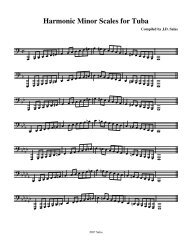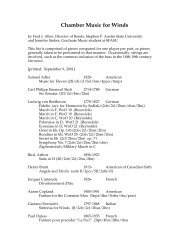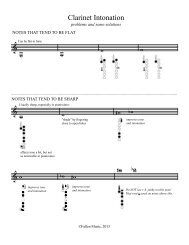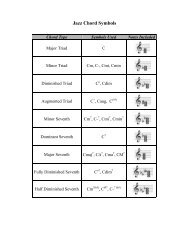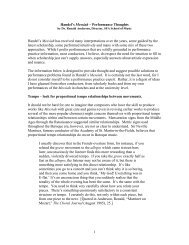Trombone Rep - History of the Trombone - Timeline 1 (EatonMensch ...
Trombone Rep - History of the Trombone - Timeline 1 (EatonMensch ...
Trombone Rep - History of the Trombone - Timeline 1 (EatonMensch ...
You also want an ePaper? Increase the reach of your titles
YUMPU automatically turns print PDFs into web optimized ePapers that Google loves.
<strong>History</strong> <strong>of</strong> <strong>the</strong> <strong>Trombone</strong><br />
P. 16<br />
Date Information Citation<br />
1769 A.D Johann Georg Albrechtsberger was an eighteenth century composer <strong>of</strong> a trombone concerto. Guion p. 75<br />
ca. 1770 A.D.<br />
Discant-posaune "from <strong>the</strong> Swedish Royal Chapel stands in about modern B flat, probably<br />
choir-pitch A."<br />
Baines p. 179<br />
1770s A.D. The trombone was not "common in French orchestras until <strong>the</strong> mid-1770s." Guion p. 169<br />
1770s A.D.<br />
1773 A.D.<br />
1773 A.D.<br />
1778 A.D.<br />
late 1700s<br />
A.D.<br />
late 1700s<br />
A.D.<br />
late 1700s<br />
A.D.<br />
<strong>Trombone</strong> returns to use in English musical life. The term Sackbut is no longer used but <strong>the</strong><br />
Italian word <strong>Trombone</strong> is now used.<br />
Gossec claims <strong>the</strong> second known use <strong>of</strong> trombones in French orchestras in his work Sabinus .<br />
(A scholar named Cucel believes this is false and stems from Gossec's jealousy <strong>of</strong> Gluck and<br />
his innovative use <strong>of</strong> <strong>the</strong> trombone.)<br />
Supossing <strong>the</strong> Gossec's claim to <strong>the</strong> first use <strong>of</strong> trombone is false, <strong>the</strong> first composer to use<br />
trombones is Jean-Joseph Rodolphe in his opera Isamenor .<br />
Roland , by Nicola Piccinni, "is ahead <strong>of</strong> its time in requiring only one trombone and in not<br />
having any supernatural connotations or any o<strong>the</strong>r identifiable affactive significance except<br />
possibly sadness or sorrow." "The most unusual feature is that [<strong>the</strong> trombone] does not<br />
always have <strong>the</strong> longest notes in <strong>the</strong> texture. In fact, for one brief moment, <strong>the</strong> trombone has<br />
<strong>the</strong> most active <strong>of</strong> <strong>the</strong> wind parts, and this in a fast movement."<br />
The first symphony that documents <strong>the</strong> use <strong>of</strong> trombones is Beck's Symphony in <strong>the</strong> key <strong>of</strong><br />
Eb fourty-four years before Beethoven's Fifth Symphony.<br />
Gluck widely uses trombones in his works: Iphigenie en Aulide (1774), Orphee et Euridice<br />
(1774), Alceste (1776), Iphigenie en Tauride (1779), Echo et Narcisse (1779) . In his works,<br />
Gluck "nearly always uses trombones to signify <strong>the</strong> supernatural or funereal aspects <strong>of</strong> <strong>the</strong><br />
drama."<br />
Guion P. 3<br />
Guion p. 171<br />
Guion p. 172<br />
Guion p. 250<br />
Guion p. 267<br />
Guion p. 173<br />
<strong>Trombone</strong>s are used in a "significant number" <strong>of</strong> French operas and ballets - potentially 21. Guion p. 174


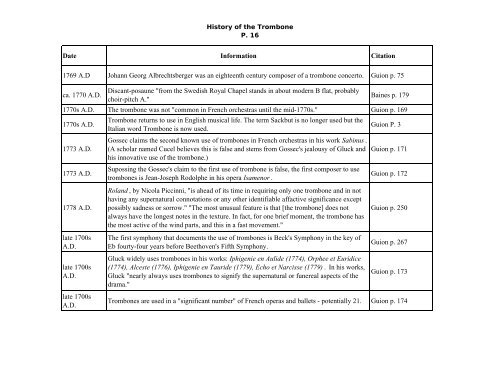
![Finale 2008 - [Whole Tone Scales - Tuba.MUS]](https://img.yumpu.com/50937649/1/190x245/finale-2008-whole-tone-scales-tubamus.jpg?quality=85)

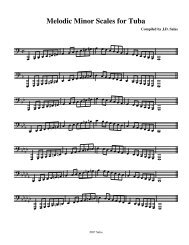
![Finale 2008 - [Chromatic Scales - Tuba.MUS]](https://img.yumpu.com/36500491/1/190x245/finale-2008-chromatic-scales-tubamus.jpg?quality=85)
